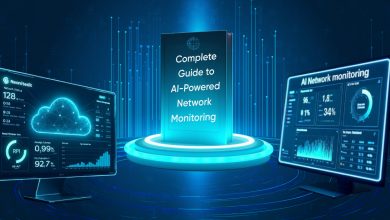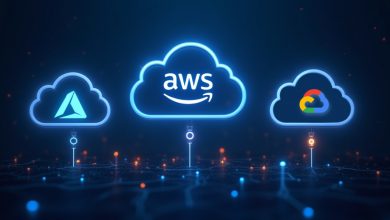5G Network Monitoring Challenges and Solutions

Introduction
5G is changing digital experiences, high-bitrate video, edge applications (software running close to end users), and billions of devices while exposing the limits of legacy monitoring. Cloud-native cores (virtualized, container-based mobile core networks), network slicing (multiple virtual networks on shared infrastructure), and multi-vendor stacks generate huge amounts of telemetry (logs, metrics, and traces) that are hard to unify. The result is a familiar pattern: disconnected tools, alert fatigue, and slow root-cause analysis when milliseconds matter.
The report covers the 5G monitoring challenges and the best approaches, including AI observability to tie signals together, agent-based automation to operationalize insights, and forecasting to detect issues early.
A unified network observability platform, like ScoutITAi, connects infrastructure, applications, and networks to enable real-time monitoring, reduced mean time to repair (MTTR), and plain-language insights for technical and business stakeholders.
5G Network Monitoring Challenges and Solutions
1) Massive Data Volume and Complexity
Challenge:5G networks generate a huge amount of real-time data from millions of devices, sensors, and applications. Managing real-time visibility into such a big, fast data stream is hard.
Solution:Deploy AI- and ML-powered analytics tools that can automatically filter, process, and interpret big datasets. Managing real-time visibility into such a big, fast data stream is hard.
2) Low Latency and Real-Time Performance Tracking
Challenge:One of 5G’s biggest promises is ultra-low latency (as low as 1 ms). Monitoring systems must be able to track latency, jitter, and throughput in real time without adding overhead.
Solution:Use distributed and edge-based monitoring architectures that capture metrics closer to the data source. This ensures real-time visibility and faster detection of performance issues.
3) Network Slicing Visibility
Challenge:5G introduces network slicing, multiple virtual networks on the same infrastructure. Each slice may have different performance requirements, making monitoring a complex task.
Solution:Implement slice-aware monitoring solutions that provide end-to-end visibility across slices. These tools should give granular insights into the performance, resource usage, and SLA compliance of each slice.
4) Virtualization and Cloud-Native Environments
Challenge:5G networks rely heavily on virtualization (NFV) and cloud-native technologies (CNFs). Monitoring dynamic, containerized, and multi-cloud environments is hard.
Solution:Use unified observability platforms that collect data from physical, virtual, and cloud layers. Container monitoring tools like Prometheus and Grafana can improve visibility across virtualized environments.
5) Security Monitoring and Threat Detection
Challenge:The massive scale and distributed nature of 5G increases the risk of cyberattacks and malicious activity. Continuous monitoring for unusual behavior and security breaches is a must.
Solution:Incorporate AI-driven threat detection, anomaly identification, and automated incident response mechanisms. Security Information and Event Management (SIEM) and Zero Trust frameworks can strengthen 5G monitoring.
Step-by-step methods to reduce MTTR and alert fatigue
6) Interoperability Between Vendors and Systems
Challenge:5G networks often include equipment and software from multiple vendors, each with its own monitoring interfaces and standards. This fragmentation can create data silos.
Solution:Use open APIs, standardized monitoring protocols (like 3GPP and TM Forum standards), and vendor-neutral observability tools to unify insights across different systems.
7) Energy Efficiency and Resource Optimization
Challenge:5G’s dense network of small cells and edge nodes consumes a lot of energy. Monitoring tools must track power consumption and help optimize energy efficiency.
Solution:Use intelligent monitoring systems that correlate performance metrics with power consumption. AI can recommend power-saving configurations during off-peak hours without compromising network quality.
8) Automation and Self-Healing Networks
Challenge:Manual network monitoring is no longer feasible in large-scale, distributed 5G environments. Operators need autonomous systems that can detect and fix issues proactively.
Solution:Leverage AI/ML-driven automation for closed-loop operations where monitoring systems can automatically adjust network parameters or trigger self-healing actions to maintain optimal performance.
9) End-to-End Customer Experience (QoE) Correlation
Challenge:Even if KPIs are delayed and jitter, packet loss, and throughput meet targets, users may still experience slow applications or buffering. Correlating RAN and core network metrics with application performance and business outcomes (conversions, churn, Net Promoter Score [NPS]) is still hard.
Solution:User experience is measured by showing network statistics and application metrics together with edge tests and real-user data, aligned to each slice’s SLA.
10) Transport (Fronthaul/Backhaul) Visibility
Challenge:5G performance relies on fronthaul and backhaul transport. These layers may experience congestion, packet loss, or path asymmetry that degrades slices and services; however, fault isolation across multi-vendor, multi-carrier links is hard.
Solution:End-to-end monitoring of fronthaul/backhaul should identify delay, loss, and congestion; precise timing, active testing, and flow telemetry should then isolate the fault.Use policy controls to adjust routing, scale capacity, or rectify configurations and restore performance.
5G Monitoring Best Practices
1. Unify Telemetry
Collect data from infrastructure, applications, and networks into one observability platform. No more silos, no more root-cause analysis headaches, and a complete view of the network.
2. Instrument the Edge (MEC)
Monitor latency, jitter, and quality of experience (QoE) as close to the end user as possible. Edge monitoring for real-time insights for responsive applications and ultra-low latency services.
3. Slice-Aware Monitoring
Design monitoring to be slice-aware so SLAs, security policies, and capacity management can apply to each network slice individually. Consistent performance and compliance across multiple virtual networks.
4. AI-Driven Observability
Use AI to reduce alert noise, correlate disparate signals, and provide plain language insights. AI observability for anomaly detection, faster troubleshooting, and decision-makers with actionable intelligence.
Conclusion
5G increases both opportunity and complexity. Keeping up requires more than dashboards, namely AI observability, slice-aware visibility, and agent-driven automation that turns telemetry into decisions. With unified monitoring across infrastructure, applications, and networks, organizations can predict risk, reduce mean time to repair (MTTR), and deliver a good customer experience.
5G monitoring modernization is available through AI-driven observability and automation.
ScoutITAi’s network observability platform gives real-time insights, AI-powered analysis, and automation for hybrid environments.
Book a demo or learn more at ScoutITAi.
Frequently Asked Questions
5G network monitoring tracks real-time performance, availability, and security across RAN, transport, and the cloud-native 5G core. With network observability, operators get end-to-end visibility to maintain QoS, reduce MTTR, and ensure reliable 5G experiences.
Cloud-native 5G cores, network slicing, and multi-vendor stacks generate massive, siloed telemetry (logs, metrics, traces). The result is alert fatigue, slow root-cause analysis, and gaps in service-level monitoring without a unified observability platform.
AI-driven observability correlates signals across layers, detects anomalies in milliseconds, and accelerates root-cause analysis. It powers predictive insights and plain-language summaries so NOCs act faster with higher confidence.
Track per-slice KPIs like latency, throughput, jitter, and packet loss along with per-slice topology and intents. Slice-aware dashboards and policy-based alerts help enforce SLA compliance and isolate faults without impacting other slices.
Focus on latency, jitter, packet loss, throughput, attach success rate, handover success rate, call drop rate, control/user plane health, and MTTR. Tie these KPIs to service-level objectives (SLOs) for each application or slice.
Use AI-based alert correlation, deduplication, and dynamic thresholds to cut noise. Group symptoms by service impact and automate escalation with runbooks to shrink meantime to acknowledge (MTTA) and MTTR.
Ingest telemetry from gNodeB/RAN, fronthaul/midhaul/backhaul, and the 5G core (AMF/SMF/UPF) into a single data model. Techniques like OpenTelemetry, flow records, eBPF, and service-mesh tracing enable hop-by-hop visibility.
AIOps drives closed-loop automation to detect, diagnose, and remediate with self-healing actions. It standardizes responses via runbooks, scales operations, and keeps SLA targets despite traffic spikes.
A single-pane platform unifies metrics, logs, traces, and topology, eliminating swivel-chair troubleshooting. It shortens MTTR, provides business-level insights, and supports multi-cloud and multi-vendor environments.
Apply predictive analytics on historical KPIs to anticipate demand by location, slice, and time-of-day/seasonality. Proactive scaling and smart placement at the edge prevent congestion and safeguard user experience.

Tony Davis
Director of Agentic Solutions & Compliance




